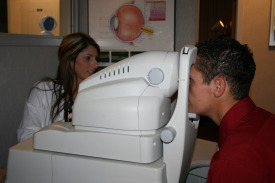Visian ICL
Intraocular contact lenses (ICL) are microlenses that are placed inside your eye to correct high degrees of nearsightedness (>-20.00) and farsightedness (>+5.00). It is similar to a permanent contact lens placed inside the eye. Patients who would benefit from an ICL are those who have a strong glasses prescription, thin corneas or prefer a non-laser vision correction.
The surgical technique is similar to that used in cataract surgery, the major difference being that the natural lens is not removed and remains functional. Using topical or local anesthetic, the surgeon creates a small incision in the eye and inserts the lens using specialized instruments. The exact technique and placement of the implant will differ depending on the type of lens implant chosen. While an increase in vision may be noticed soon after the procedure, the patient will not fully realize the visual benefits of the implant for 6 to 8 weeks following the procedure, during which time the eye is healing. In some individuals, another type of vision correction may be chosen to further enhance the patient’s vision.
The Staar Visian ICL™
The Staar ICL™ is placed inside the eye surgically without laser removal of corneal tissue or removal of the natural lens. By not removing the natural lens, the eye can still focus from far to near without the need for reading glasses or a reading contact lens.
The Staar Visian ICL™ is indicated for the correction of nearsightedness (-3.00 to -20.00 D) and farsightedness or hyperopia (+3.00 to +20.00 D). It is anchored in front of the crystalline lens behind the pupil of the eye and functions much like a traditional contact lens except that it is left indefinitely and cannot be seen or felt by the patient. Surgical results are effective immediately, with only a short recovery period.
Frequently Asked Questions:
Q: Is the Staar ICL™ permanent?
A: The Staar ICL™ is designed to be permanent inside the eye. However, unlike laser procedures that permanently remove tissue from the eye, the Staar ICL™ is removable and replaceable.
Q: Are both eyes implanted with Staar ICLs™ at the same time?
A: Not usually. The eyes are usually implanted 1-2 weeks apart.
Q: Can the Staar ICL™ correct all degrees of nearsightedness and farsightedness?
The Staar ICL™ is able to correct nearsightedness from -3.00 to -20.00 and farsightedness +3.0 to +20.
Q: Can the Staar ICL™ focus both far and near?
A: No. The Staar ICL™ does not focus far and near, the natural crystalline lens provides the ability to focus far and near for most people under age 45.
Q: Are there risks of complications associated with Staar ICLs™?
A: As with any surgical procedure, there are risks of complications. The Staar ICL™ is placed inside the eye behind the iris (colored part of the eye) and in front of the eye’s focusing lens. An occasional patient (less than 3%) may develop a cataract. Although most of these cataracts are not progressive requiring surgery, a rare patient may require removal of the Staar ICL™, removal of the cataract, and implantation of a new lens to clear and correct the vision.
Q: Can I have a Staar ICL™ if I’ve had LASIK?
A: Yes, and vice versa. A LASIK patient who did not receive full vision correction from the laser procedure can have certain degrees of residual or recurrent refractive errors corrected by implantation of a Staar ICL™. Alternatively, a Staar ICL™ patient who has a residual refractive error can have LASIK to “fine-tune” the vision.
